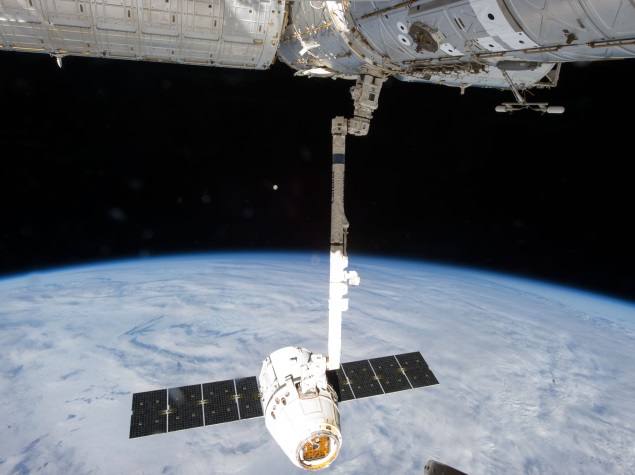- Home
- Science
- Science News
- Nasa's SMAP Satellite to Help Farmers Combat Drought
Nasa's SMAP Satellite to Help Farmers Combat Drought

Currently, there is no ground- or satellite-based global network monitoring soil moisture at a local level.
Farmers, scientists and resource managers can place sensors in the ground, but these only provide spot measurements and are rare across some critical agricultural areas in Africa, Asia and Latin America.
Nasa's Soil Moisture Active Passive (SMAP) satellite mission, scheduled to launch in November, will collect the kind of local data agricultural and water managers worldwide need.
SMAP uses two microwave instruments to monitor the top 5 centimetres of soil on Earth's surface.
Together, the instruments create soil moisture estimates with a resolution of about 9 kilometres mapping the entire globe every two or three days.
Although this resolution cannot show how soil moisture might vary within a single field, it will give the most detailed maps yet made.
"Agricultural drought occurs when the demand for water for crop production exceeds available water supplies from precipitation, surface water and sustainable withdrawals from groundwater," said Forrest Melton, a research scientist in the Ecological Forecasting Lab at Nasa Ames Research Centre in Moffett Field, California.
"Based on snowpack and precipitation data in California, by March we had a pretty good idea that by summer we'd be in a severe agricultural drought," Melton added.
"But irrigation in parts of India, the Middle East and other regions relies heavily on the pumping of groundwater during some or all of the year," Melton said.
Underground water resources are hard to estimate, so farmers who rely on groundwater have fewer indicators of approaching shortfalls than those whose irrigation comes partially from rain or snowmelt.
For these parts of the world where farmers have little data available to help them understand current conditions, SMAP's measurements could fill a significant void.
Some farmers handle drought by changing irrigation patterns. Others delay planting or harvesting to give plants their best shot at success.
Currently, schedule modifications are based mostly on growers' observations and experience. SMAP's data will provide an objective assessment of soil moisture to help with their management strategy.
"If farmers of rain-fed crops know soil moisture, they can schedule their planting to maximise crop yield," said Narendra Das, a water and carbon cycle scientist on SMAP's science team at Nasa's Jet Propulsion Laboratory in Pasadena, California.
"SMAP can assist in predicting how dramatic drought will be, and then its data can help farmers plan their recovery from drought," said Das.
Catch the latest from the Consumer Electronics Show on Gadgets 360, at our CES 2026 hub.
Related Stories
- Samsung Galaxy Unpacked 2025
- ChatGPT
- Redmi Note 14 Pro+
- iPhone 16
- Apple Vision Pro
- Oneplus 12
- OnePlus Nord CE 3 Lite 5G
- iPhone 13
- Xiaomi 14 Pro
- Oppo Find N3
- Tecno Spark Go (2023)
- Realme V30
- Best Phones Under 25000
- Samsung Galaxy S24 Series
- Cryptocurrency
- iQoo 12
- Samsung Galaxy S24 Ultra
- Giottus
- Samsung Galaxy Z Flip 5
- Apple 'Scary Fast'
- Housefull 5
- GoPro Hero 12 Black Review
- Invincible Season 2
- JioGlass
- HD Ready TV
- Laptop Under 50000
- Smartwatch Under 10000
- Latest Mobile Phones
- Compare Phones
- OPPO Reno 15 Pro Max
- Honor Win RT
- Honor Win
- Xiaomi 17 Ultra Leica Edition
- Xiaomi 17 Ultra
- Huawei Nova 15
- Huawei Nova 15 Pro
- Huawei Nova 15 Ultra
- Asus ProArt P16
- MacBook Pro 14-inch (M5, 2025)
- OPPO Pad Air 5
- Huawei MatePad 11.5 (2026)
- Xiaomi Watch 5
- Huawei Watch 10th Anniversary Edition
- Acerpure Nitro Z Series 100-inch QLED TV
- Samsung 43 Inch LED Ultra HD (4K) Smart TV (UA43UE81AFULXL)
- Asus ROG Ally
- Nintendo Switch Lite
- Haier 1.6 Ton 5 Star Inverter Split AC (HSU19G-MZAID5BN-INV)
- Haier 1.6 Ton 5 Star Inverter Split AC (HSU19G-MZAIM5BN-INV)

















